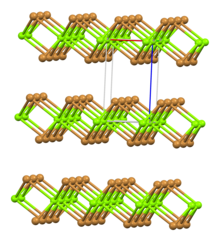Magnesium bromide
 | |
 | |
| Identifiers | |
|---|---|
CAS Number |
|
3D model (JSmol) |
|
| ChemSpider |
|
| ECHA InfoCard | 100.029.246 |
PubChem CID |
|
| UNII |
|
CompTox Dashboard (EPA) |
|
InChI
| |
| |
| Properties | |
Chemical formula |
|
| Molar mass | 184.113 g/mol (anhydrous) 292.204 g/mol (hexahydrate) |
| Appearance | white hygroscopic hexagonal crystals (anhydrous) colorless monoclinic crystals (hexahydrate) |
| Density | 3.72 g/cm3 (anhydrous) 2.07 g/cm3 (hexahydrate) |
| Melting point | 711 °C (1,312 °F; 984 K) 172.4 °C, decomposes (hexahydrate) |
| Boiling point | 1,250 °C (2,280 °F; 1,520 K) |
Solubility in water | 102 g/(100 mL) (anhydrous) 316 g/(100 mL) (0 °C, hexahydrate) |
| Solubility | ethanol: 6.9 g/(100 mL) methanol: 21.8 g/(100 mL) |
| −72.0·10−6 cm3/mol | |
| Structure | |
| Rhombohedral, hP3 | |
| P-3m1, No. 164 | |
| octahedral | |
| Thermochemistry | |
Heat capacity (C) | 70 J/(mol·K) |
Std molar entropy (S⦵298) | 117.2 J·mol−1·K−1 |
Std enthalpy of formation (ΔfH⦵298) | −524.3 kJ·mol−1 |
| Hazards | |
| NFPA 704 (fire diamond) |  1 0 0 |
| Safety data sheet (SDS) | External SDS |
| Related compounds | |
Other anions | |
Other cations | |
Except where otherwise noted, data are given for materials in their standard state (at 25 °C [77 °F], 100 kPa).  N verify (what is N verify (what is  Y Y N ?) N ?) Infobox references | |
Magnesium bromide is a chemical compound of magnesium and bromine, with the chemical formula MgBr2. It is white and deliquescent crystalline solid. It is often used as a mild sedative and as an anticonvulsant for treatment of nervous disorders.[2] It is water-soluble and somewhat soluble in alcohol. It can be found naturally in small amounts in some minerals such as: bischofite and carnallite, and in sea water, such as that of the Dead Sea.[3][4]
Synthesis
Magnesium bromide can be synthesized by treating with magnesium oxide (and related basic salts) with hydrobromic acid.[4] It can also be made by reacting magnesium carbonate and hydrobromic acids, and collecting the solid left after evaporation.[3]
As suggested by its easy conversion to various hydrates, anhydrous MgBr2 is a Lewis acid. In the coordination polymer with the formula MgBr2(dioxane)2, Mg2+ adopts an octahedral geometry.[5]
Uses
Magnesium bromide is used as a Lewis acid catalyst in some organic synthesis, e.g., in aldol reaction.[6] In organosilicon chemistry, magnesium bromide forms adducts R2SiXMgBr2.[7]
Magnesium bromide also has been used as a tranquilizer.[3]
Magnesium bromide modifies the catalytic properties of palladium on charcoal.[8]
Magnesium bromide hexahydrate has properties as a flame retardant. It was found that if 0.125 mol/L of magnesium bromide hexahydrate was added to a cotton material it acted as a flame retardant.[9]
References
- ^ Lide, David R. (1998). Handbook of Chemistry and Physics (87 ed.). Boca Raton, Florida: CRC Press. pp. 4–67. ISBN 0-8493-0594-2.
- ^ Pradyot Patnaik. Handbook of Inorganic Chemicals. McGraw-Hill, 2002, ISBN 0-07-049439-8
- ^ a b c Gruyter, W. Concise Encyclopedia Chemistry, Walter de Gruyter & Company: Berlin, 1993; 612
- ^ a b Lewis, R.J. Hawley’s Condensed Chemical Dictionary, 15th ed.; John Wiley &Sons Inc.:New York, 2007; 777
- ^ Fischer, Reinald; Görls, Helmar; Meisinger, Philippe R.; Suxdorf, Regina; Westerhausen, Matthias (2019). "Structure–Solubility Relationship of 1,4‐Dioxane Complexes of Di(hydrocarbyl)magnesium". Chemistry – A European Journal. 25 (55): 12830–12841. doi:10.1002/chem.201903120. PMC 7027550. PMID 31328293.
- ^ Evans, David A.; Tedrow, Jason S.; Shaw, Jared T.; Downey, C. Wade (2002). "Diastereoselective Magnesium Halide-Catalyzed anti-Aldol Reactions of Chiral N-Acyloxazolidinones". Journal of the American Chemical Society. 124 (3): 392–393. doi:10.1021/ja0119548. PMID 11792206.
- ^ Lim, Young Mook; Cho, Hyeon Mo; Lee, Myong Euy; Baeck, Kyoung Koo (2006). "A Stable Magnesium Bromosilylenoid: Transmetalation of a Lithium Bromosilylenoid by Magnesium Bromide". Organometallics. 25 (21): 4960. doi:10.1021/om060589w.
- ^ Bouzide, Abderrahim (2002). "Magnesium Bromide Mediated Highly Diastereoselective Heterogeneous Hydrogenation of Olefins". Organic Letters. 4 (8): 1347–50. doi:10.1021/ol020032m. PMID 11950359.
- ^ Mostashari, S. M.; Fayyaz, F. (2008). "XRD characterization of the ashes from a burned cellulosic fabric impregnated with magnesium bromide hexahydrate as flame-retardant". Journal of Thermal Analysis and Calorimetry. 92 (3): 845. doi:10.1007/s10973-007-8928-4. S2CID 94416902.
- v
- t
- e












